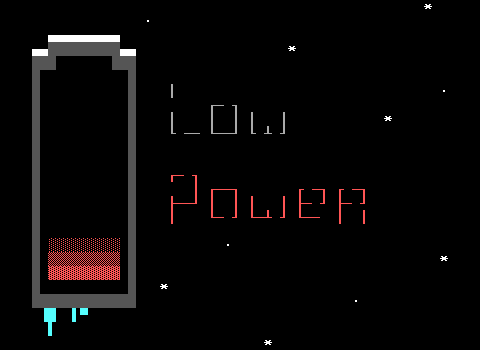Well, I did finally goof and miss my window to get a poll up in a timely manner so Gladiator is no one's pick but my own. I hope you'll forgive me! And I hope you won't mind that I'll take this opportunity to immediately play its sequel for what's meant to be my own pick next time.
While at first I thought I'd try and pick something that I normally might not otherwise, as some bizarre self-imposed punishment (as if the hundred-something Wildcard Streams haven't made me immune to such things), Gladiator wound up being a lot more memorable of a game than it initially let on. Its deceptively simple title screen contains a text blurb emphasizing it as a game to be taken seriously. I absolutely did not trust it to deliver.
This one also appears to author Cliff Hensley's first release. ...not actually an indicator that a game won't be good, especially in the more modern age where first-time ZZTers are regularly creating excellent work, but again, not confidence inspiring. I could come up with reasons why I might expect the game to not be good, but something something book covers. Besides, the more I pre-emptively looked for negatives, the ruder I was being to Hensley anyway.
If I was looking for punishment, the only way I'd be able to find it with Gladiator would be for the all too common fault of a trilogy of games that never actually gets made. "The Sundering" sadly not being available. Though I'm getting ahead of myself, I have to finish up this first article before I start playing the next game and getting sad about the lack of closure.
And sparse title screens aside, I'm really looking forward to it! Gladiator has been sitting here, ready to be played for as long as I've been ZZTing, and boy do I wish I got around to it sooner. This is a new favorite for sure, and I've got to stream it sometime. The secret to its success is how much Hensley's writing builds up otherwise basic environments and fantasy character archetypes to a level of detail that's almost unheard of in ZZT games from the 90s. While it doesn't have much in the way of surprises in the plot, it nails the fundamentals to an impressive degree.
As far as the gameplay goes, Gladiator is remarkably simple. While a 1996 release is still a bit early to expect the RPG engines that would be seemingly everywhere just a few years later, they certainly weren't unheard of. Expect no such thing here. You get to run around with your sword, shooting (do not ask) at Tim Sweeney's (least?) favorite zoo animals. It's nothing special, simple filling a role of making sure that the shift key gets held down once in awhile.
Gladiator isn't not the only game I've seen where beginner-level action feels quaint when compared to its significantly more complex writing, and the comparison I have in mind is what I'm going to use to sell you on this one before things get underway. Gladiator feels like Hensley wanted to make his own Ezanya, the now legendary winner of the original ZZT world making contest.
So grab your legendary blade and prepare to defeat the rising forces of darkness before the world as we know it is no more. Prepare for Gladiator!
A Brief History of Atheria
Through interviewing Beth Daggert, we know that Ezanya was inspired by computer RPGs on the Apple II. Thanks to a helpful readme, it would appear that Atheria, the world of Gladiator, has its own roots in pen and paper RPGs. The readme explains how the world has been developed for years on paper, only making its appearance on computers for the first time with Gladiator. To help newcomers follow the story better, a few concepts of the greater story are explained.
There's "The conflict of Light and Dark", where Beings of Light and mortals used to live in harmony in Atheria until mankind was tricked by the incredibly named Darque Ness from the underworld, causing mankind to lose their purity and thus preventing the beings of light from being able to continue living in Atheria.
Some people thought it kind of sucked that the beings of light had to leave, and wanted to continue to upload their ideals. These mortals formed "The Knights of the Eternal Order", vowing to defend humanity from darkness and to eventually vanquish Darque Ness, removing his corrupting influence from mankind. These knights manage to seal him away, but seals are made to be broken. Knowing it was possible for Darque Ness to return one day, a magical sword known as Gladiator was forged. The sword's wielder would swear an oath to defend the realm from the forces of darkness, passing the blade down through the ages.
The key to all this lies in The Tower of Graylomman. This tower sits high atop Mount Dragon and serves as a gateway both to the netherworld and to the Realm of Light. The tower represents the intersection of the mortal world, with that of light and darkness. Whoever controls the tower is able to make use of the power of all the realms, making them "supreme, omniscient, and practically undefeatable". The game's story revolves around Darque Ness breaking the seal that traps him in the netherworld and his subsequent attempt to claim the tower as his to control in order to usher in a new dark age with himself as the king of all realms.
You play as the current wielder of Gladiator, the equally incredibly named "Sir Edgar Knight". When the seal finally breaks, you are the only one who can stand up to evil and prevent the coming of a new dark age.
It's all quite a bit of pre-game introduction, and it certainly builds up the game quite a bit. Gladiator has the luxury of getting to make an impression before the actual first impression. All of this to me suggests that Hensley cares about this world. It's more than just something made up to give the player a reason to shoot some ruffians.
Limited Code
Hensley has a story to tell, and by god he's going to tell it. The writing is here, the programming less so. For example, when Darque Ness and his second-in-command Elandra taunt the player from atop Graylomman, Elandra is put in charge of killing Edgar. She goes for the giant snake approach.
--A big green centipede is already present on the board, placed at a comfortable distance to not be in the player's hair while they're focused on the villains' banter.
Big centipedes that aren't already up close don't make for much a threat though. I figured that before I'd fight the thing, I'd take a look at the seemingly double-locked door to the tower and see if I could get any info on what I might need to find to unlock it. Touching the first door instead caused Elandra to act as if I had defeated her pet.
Hensley doesn't have the best grasp of ZZT-OOP to say the least. Still, just as with Joe Blow Socipoon, not fully grasping ZZT-OOP doesn't have to mean giving up on your ideas. We saw froznfire in Joe Blow relying on players following instructions, and placing NPCs in such a way that players would choose to interact with them instead of skipping past their contributions. Players are going to prioritize what's nearby instead of taking a back-and-forth route across the same screen. For Joe Blow, this would mean talking to a man who tells you to go to the library, relying on player behavior to keep them from going to the library first and reacting to events there as if they had already talked to the man.
Hensley tries the same thing in Gladiator, though not always quite as effectively. In our snake example, making sure the snake served as some level of obstruction to reaching the tower would have likely gotten me to deal with the snake first.
Elsewhere, the technique serves Hensley well. Players will want to follow the directions they receive out of a genuine interest in what will happen when they reach their next location. You'd be reluctant to try exploring elsewhere early despite the lack of progression flags, as Hensley is still very much capable of using locked doors to prevent players from jumping too far ahead in the story. Keys are the only real way the game is able to track what the player has or hasn't done yet. It's a bit cumbersome, but if it's this or no Gladiator, I'll take the keys any time.
The game's code features some other oddities as well. One of which I just can't figure out. Every single object that produces text in the game has a :TEXT label at the start of it. Objects that have multiple sections of text will get multiple labels. Hensley is thoroughly committed to doing this, and I don't understand why. At no point in the code have I seen anything reference that label. I suppose it's a way to organize code, but there's nothing in this game nearly so complex as to need organization.
The programming here is very simple, with several of ZZT's commands never being used at all. Gladiator (admirably) tells its tale without #ZAP, #SET, #CHANGE, or even #IF. You get dialog, counter adjustment (finding gems in a cabinet), some music, and buttons to press that cause certain walls to disappear, and that's pretty much it.
The walls show a tragic misunderstanding of ZZT-OOP too. This is a new kind of bad coding practice that I've never seen before, and I've seen my share of poorly understood code. When Hensley wants a button to lower a large wile consisting of several tiles, he does so by making every part of the wall a uniquely named object, and then has the button run a dedicated #SEND to remove each piece.
--It's kind of incredible.
On the bright side, all of these discoveries happened after playing. The important thing is that game's code all runs without issue. Let it be known, however, that "the code works" is not the same as "the game is bug free".
Dark Forces Hate Him: One Weird Trick To Save Humanity
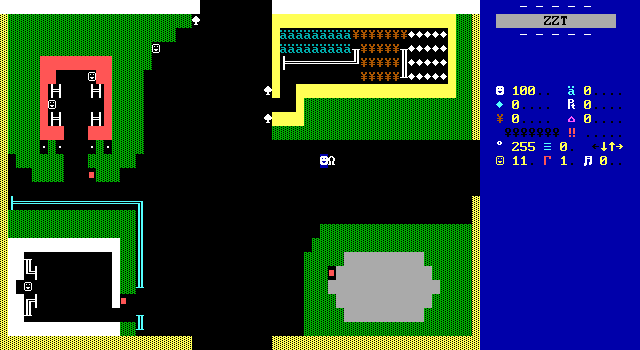
The main adventure in Gladiator is a big carrot on a stick chase. The game begins with Edgar having just arrived in the castle town where king Halon was summoned him. We don't really get much backstory on Edgar. Where he comes from and how he came wield the holy sword that has passed on through the ages are left as unknowns, making him a fairly blank slate at the start of the game.
The town is peaceful enough. Hensley keeps his towns light on detail. He's uninterested in drawing homes players can't enter, or filling his taverns with little tables. Everything instead has a purpose to serve. There's the shop to buy some pricey supplies, a wishing well to throws gems at and see what will happen, a small armory for players to get some initial supplies (for once with guards who are happy to let you have it), and the local tavern where you can find out what happened to the last guy who went up against the forces of darkness.
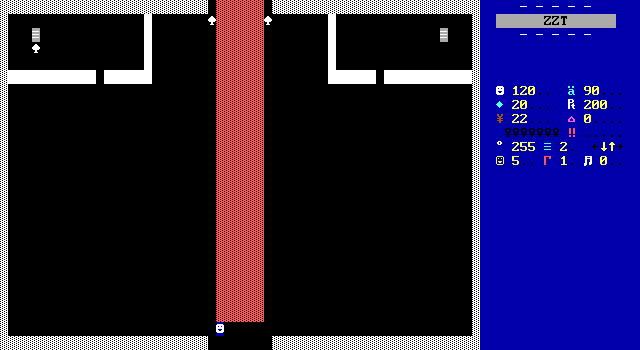
The castle, while large enough to span four boards, is even more minimal. The lack of interactive elements helps players hurry up and get on with their quest. It's got a red carpet, and that's as fancy as it will get.

There's some exploration available in the form of the castle's towers, two incredibly small rooms that again are only here to provide more supplies. In the west tower however, Sir Edgar can meet the princess and get some well-wishes before heading to the throne room to receive his quest.
Here the king informs him that the forces of darkness have managed to break through the Gate of Darkness which kept them sealed away, and Darque Ness himself led an army to storm the Tower of Graylomman. Now with the tower in his possession, it's only a matter of days until the planets are aligned and Darque can claim true reign over it, granting him immeasurable power and leading to a new dark age for mankind.
But the Eternal Order planned for just such a contingency. They forged the Talisman of Light which is capable of banishing beings of darkness back to their own realm. The plan is to use the talisman to give Darque the boot, which would then provide the clerics the time they need to seal the gate once more. Edgar's quest begins with the search for the talisman, whose recovery, or lack thereof, will determine the fate of the world.
Lucky for Edgar then, that this is no lost mythical treasure. Much like the Gladiator sword has been passed down throughout the years, so too has the talisman, which has been guarded by a dedicated member of the Eternal Order in a cave just south of the kingdom.
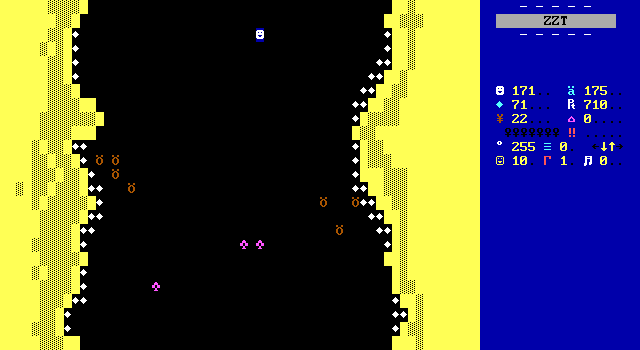
That cave is just a few boards away, with little more than a few bears and ruffians obstructing Edgar. This is the kind of game where the fighting is unusually gentle. Nearly two hundred ammo is freely found before encountering barely a dozen foes. The strength of the one who wields Gladiator isn't an embellishment. You're playing an incredibly strong warrior, and the game lets you embrace that. It's going to take a lot more than some brigands along the pass to stop you.
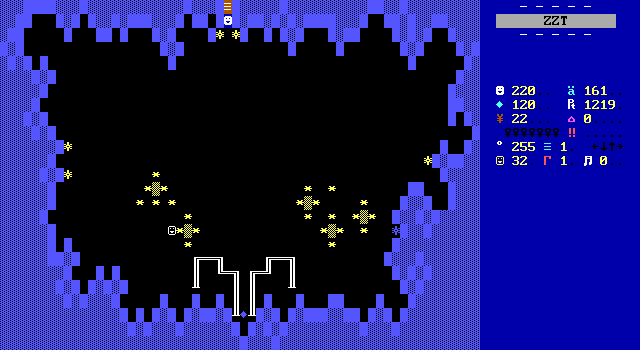
Upon arriving in the cave the talisman is nowhere to be found. Its protector lies on the floor, bleeding out from an attack by unspecified assailants who have taken the talisman back to the tower, where it now resides in Darque's hands. Climbing mount Dragon to reach the tower would take days! All is lost.
Unless...
...unless the Order had another contingency. This time, it's a secret passage through a tunnel that runs through the mountain. The guardian gives Edgar the key with his last breath and the hunt continues.
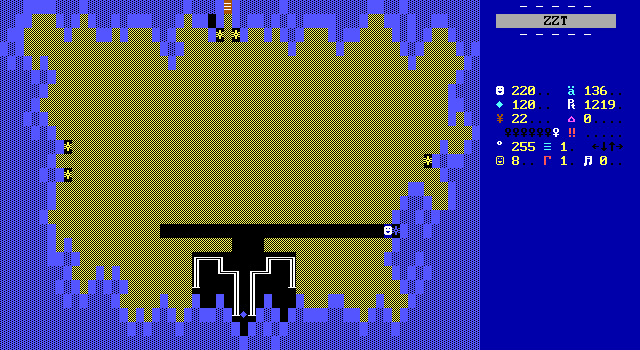
Well, it can continue once you tunnel through all the slime that has spread throughout the cave. This helps relieve players of some of their excess ammo as well as forcing players to decide if they want to try to tunnel to the torches on the walls or not to see if there's anything important contained within.
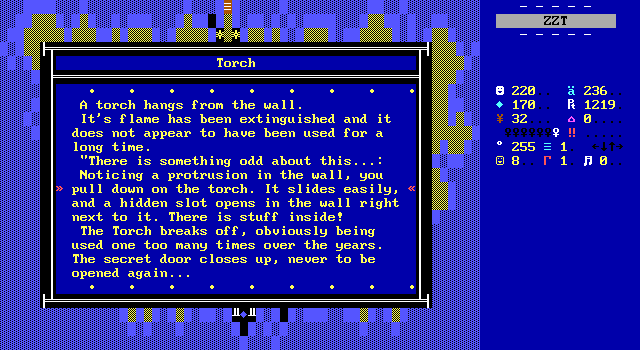
The torches on the wall are a bluff, which is honestly preferable to something game-critical only being revealed via excessive digging. Instead, it's the unlit torch, the most obvious one to investigate that pays off. It serves as a secret lever that reveals a cache of items to reward players willing to risk their ammo on the chance there may be something here.

The secret tunnel is said to be north of town, but directly north is the castle, so instead Edgar has to head out the eastern path and go around. This creates an opportunity for Hensley to tease players with a hint of what's to come. A large region of the board in inaccessible due to a locked gate with a guard stationed in front of it. He'll explain to Edgar that the gate divides the kingdom from a region known as the wasteland. These little glimpses at places players aren't yet able to reach are always something I enjoy, and here Hensley is able to make it more of a mystery than what players can immediately see.
The guard is all too happy to chat about what he's keeping locked up. This wasteland is where the kingdom disposes of its "vagrants, criminals, and [...] vilest creatures". It is absolutely off limits.
If Hensley were the type to put in world-building like this and not make it matter, perhaps the guard would be right that nobody would ever want to go beyond it. Yet even this early into the adventure you just know that at some point, this door is going to be opened.
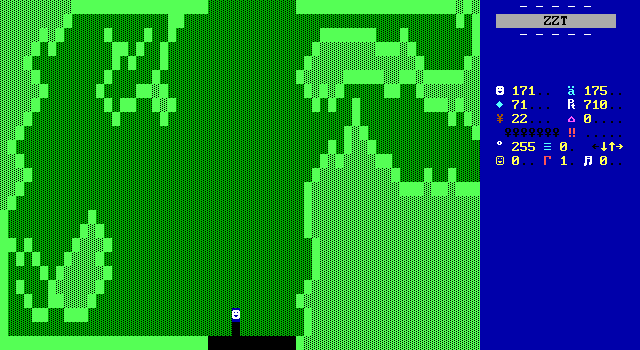
Now if only I could say anything of interest about the forest board that immediately follows.
Hensley's essentials-only approach to design works just fine when it comes to getting the game moving. Once things are underway though, it sometimes leads to boards like this that are a bit too barren for my taste.
It could be worse. Hensley still tries to add in growth that spreads inward from the board's exterior, at the very least creating a space befitting of a forest scene. There's just nothing to do! Pick a direction to travel in and pretend this board never happened.

The issue at least quickly resolves itself. Heading east you'll reach another admittedly quite empty board. This one at least offers some points of interactivity. It may not look like it, but this is the village of the elves of the forest. The minimalism strikes again. The NPCs previously included folks that set the mood of the people from nervous to doom-saying. Now that players know this, Hensley sees no need to repeat it, making the village almost eerily deserted.
In another game, a village consisting of just two people might mean a once thriving society has been nearly destroyed by the villain. Here the town is simply missing a sign that says "Population: 2". A town can be an elder and a locksmith I suppose.

Even Edgar can't resist the call of the wasteland. He can inquire about forging a royal key, but the price is steep: 300 gems for something that intricate. Gladiator has been quite generous with its gems so far sure, but you'd be forgiven for thinking that it's purposely overpriced so that it can be the king who gives you access when the time comes.
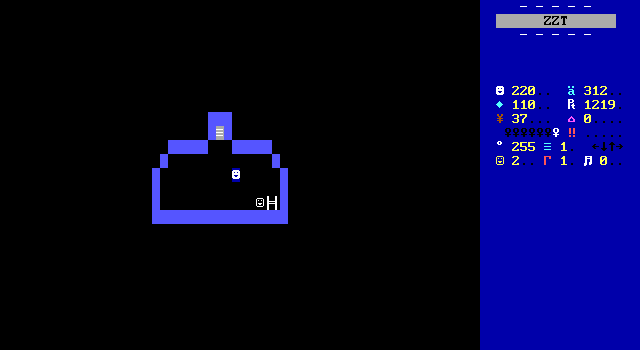
The elder's home is the emptiest screen yet. Hensley makes up for it, as he does throughout the game by instead putting the details in the writing. You're treated instead to multiple paragraphs which cover what the room is like, what the elder was doing, and the conversation between them. The elder was expecting Edgar, having had a prophetic dream that the one with Gladiator would discover their hidden village.
All of this is to get some torches and gems. The elf gives his support, but has no information. It's a rather surprising amount of text for a moment that's otherwise so mundane. I wonder if this is perhaps this world's pen and paper roots bleeding through.
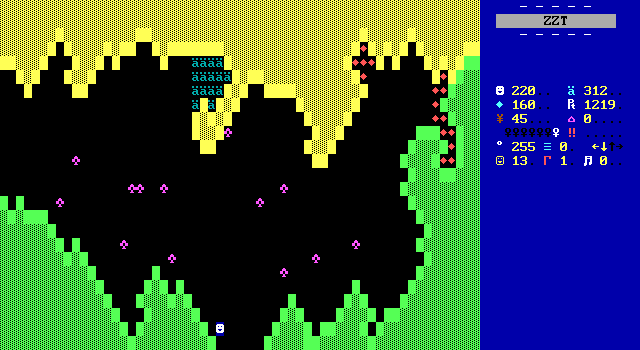
The forest, along with the path to Mount Dragon are dangerous spaces that need to be fought through. The little village is the exception. Hensley ups the difficulty a bit here, placing a far more serious number of enemies to fight in order to progress safely.
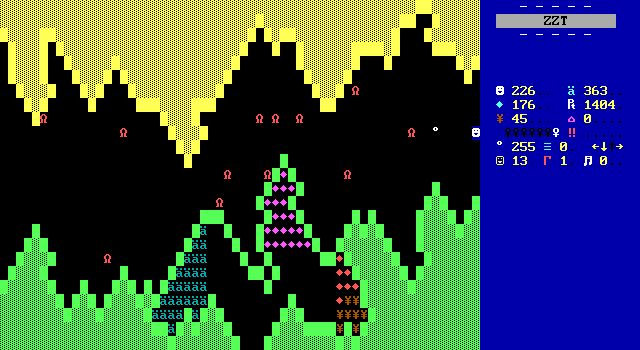
And it includes another instance of a divided board. This one had so much for the taking on the other side that it got me to turn around and explore the rest of the forest in search of the path to the goodies. The ammo on the ground of the forest is free. You can just take it.
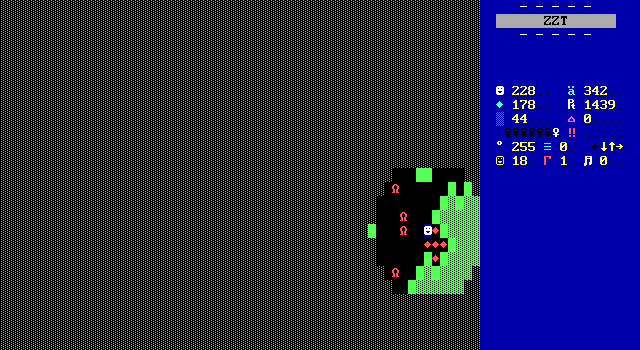
The dangerous forest boards are made more-so by being dark. The shape lets players get through the board without seeing everything, making it a commitment to see and discover everything it hides. A few small pockets of gems like these are a reward, but most of the branches quickly end in a dead-end with either nothing or more lions waiting to strike.
These diagonal paths help keep the rate at which lions reach the player low. It works well, keeping them generally confined near their origin point, allowing Hensley to spread them all over the place. This provides something to engage players regardless of the route they take. It also has the effect of preventing long distance shots from hitting anything with the extra layers of walls in the way. If you're going to fight, you'll be doing so from more dangerous ranges.

The tunnels through the mountain add another three boards to the trek to the Graylomman. It's as cramped as it is dark. Each of the three boards focuses on a different kind of enemy, ruffians, then lions, and finally bears.
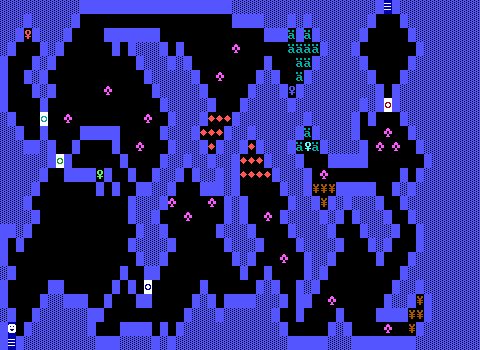
There's more to it than just shooting however. Keys and doors can be found all over the place which makes navigating much more of a process. As Gladiator is from a time long before the wisdom of making doors have identifiable colors became commonplace, there can be some moments of annoyance here when you thought the door over there was green, only to discover it's actually cyan.
One can't really blame Hensley for this. STK was available by this point, but who can say if he was aware of it. Even if he had, games from 1996 with STK aren't exactly thinking of how people in their late 30s will see their doors.

The second board introduces a staple of Gladiator's level design. Switches!
I suppose they're doors but more difficult? When you find a red key, you may have already seen the red door. With these switches, a door opens, but you won't know which until you actually observe nothing where a door once was.
In this instance, a simple puzzle is created. A note on the ground warns its reader to forget what they know. "Dark is Light, and Light is Dark". Only one of two switches can be pressed, one with a carving of a horrible beast, the other with a carving of an angelic figure bathed in light.
Not the hardest puzzle, which is good as the incorrect button triggers a cave-in and ends the game on the spot. This is the only time the game will kill players outright.
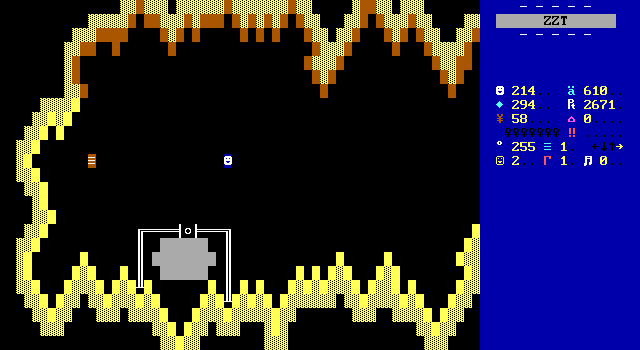
Emerging from the cave, Edgar finds himself very close to the tower. He's also very close to the Portal Light, which has been closed ever since Darque's initial attack on the mortal realm. It's pretty cool to have it not be some legend whose whereabouts have been lost to time. The portal to another world is just here.
And no, you won't be able to cross it.

The moment players enter the board that contains the tower, they're bombarded by a good amount of text that reveals a number of things. First, Darque has been expecting Edgar's arrival. Second, he has a lady friend of some sort. A "surprisingly attractive human female" dressed in all black. Her name is Elandra, and she's going to be Edgar's problem for a bit.
Darque has been chilling on the balcony the whole time just waiting for Edgar to show up so he can taunt him a bit. It's very good.
Edgar tries to play the role of the strong hero, promising that light will prevail of darkness. His words are a bit hollow right now though, as Darque gleeful points out that he has the talisman and the tower, and so he's already won. He gets the last word and takes his leave, letting Elandra deal with Edgar.
Definitely a moment where the scene the author paints is significantly more grand than what the player gets. It's a big centipede. You shoot it. It dies.

The tower is still protected though. Elandra simply laughs at her pet being slain pointing out that the door can only be opened with a key made of dwarven steel. The dwarves have been exiled long ago, and thus no key can be found in the kingdom.
...the dwarves were exiled? I feel like we're really missing out on some backstory here.
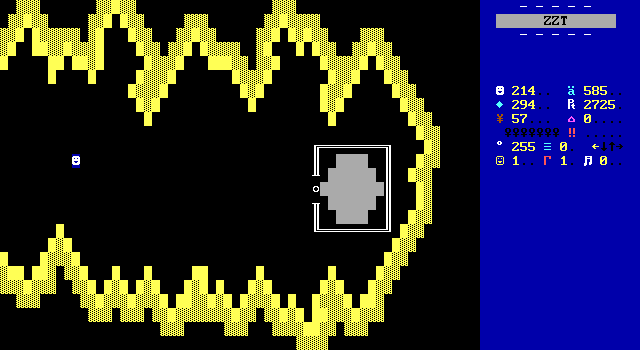

Fucked up monarchy aside, there's no way into the tower, and nothing else on Mount Dragon other than the portal to the dark world. There's an unpleasant realization here that you have to turn around at this point.
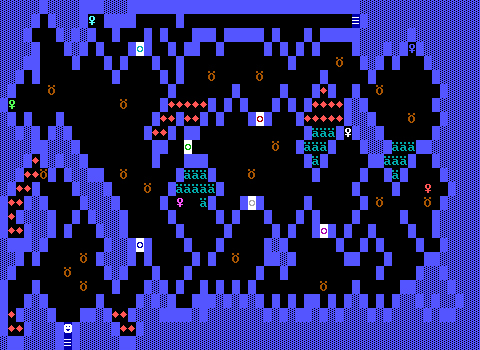
Big failure on my part. I didn't take a single screenshot of the walk back down the mountain. Presumably because the boards are all dark and at this point were devoid of any enemies.
The trip back still managed to be more eventful than an empty cavern might sound. The second room on the way up the mountain features some recessed spinning guns, so it's not truly safe until you're past them.
The return trip is also pretty awkward. Hensley uses blue passages for every one in the cave, subjecting players to the whim's of ZZT placing players on the bottom-rightmost passage of matching color. On the way in, it all works out. On the return trip, there is one point where players are placed on the passage that they should actually go through in order to continue their descent.
Programming errors: No. Passage errors: Yes.
In the dark, it's very easy to get disoriented because of this, and realize that you started going up again.
The only location yet to be explored is the wasteland, and if that's where the dwarves live (hopefully) it means that the fate of the world rests on getting the key from the king.
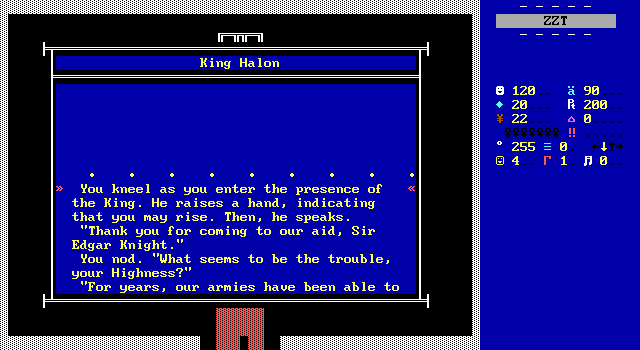
...
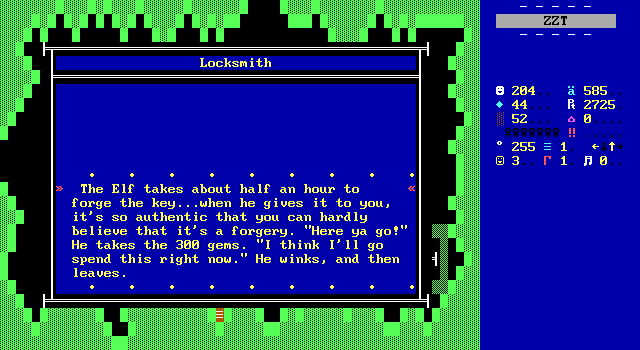
The fate of the world rests on this one elf being willing to make a forgery.
It's sadly possible to soft-lock your game and be unable to afford the purchase. There are quite a number of gems scattered around the world, and even room for a few of them to be caught in the cross-fire of your attacks and destroyed. What there isn't room for, is doing much in the way of shopping in town.
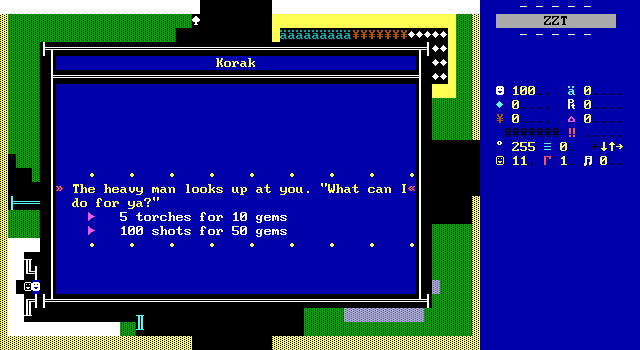
The shop sells ammo and torches at expensive prices, though with how many gems are freely collected at the start, not enough to seem worrying. If you buy both items, that's enough to not have enough funds for the key. Be wary of shopping!
Or at least use the wishing well instead. It also gives players gems and torches (and health too!) when varying amounts of gems are tossed in. This has the disadvantage that you won't know what it is you're going to get for your money, but the savings are significant. Really though, Hensley gives players everything they need and both the shop and the well feel like emergency options to get more items, ironically making it more likely the player will create an emergency that can't be resolved without cheating.

